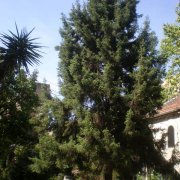Care of the shrub Juniperus brevifolia or Azores juniper |
|
The Juniperus genus, Cupressaceae family, includes 60 species of shrubs and trees native to the Northern Hemisphere. Some species are: Juniperus brevifolia, Juniperus x pfitzeriana (hybrid), Juniperus thurifera, Juniperus squamata, Juniperus phoenicea, Juniperus oxycedrus, Juniperus horizontalis, Juniperus conferta, Juniperus communis, Juniperus chinensis, Juniperus californica, Juniperus osteosperma, Juniperus drupacea. Common name: Azores juniper. This species is endemic to the Azores islands. They are dioecious shrubs or evergreen trees of pyramidal bearing that reach 6 meters (19.68 feet) in height. The small needle-like leaves are light silvery green with a dark green central line. Male cones are yellow and b female cones are first green and then orange. They bloom in spring. These slow-growing plants are used as isolated specimens and to form hedges and bushes. Azores juniper is ideal for gardens by the sea. Juniperus brevifolia prefers full sun exposure but also grows in semi-shade. It resists occasional frosts. Azores juniper grows in any well-drained soil whether it is limestone, poor or stony. Transplantation or planting is done in the fall or spring. Water moderately all year long waiting for the substrate to dry completely. Azores juniper resists drought well. Juniperus brevifolia does not need fertilizers or pruning; you only have to prune the dry branches. Azores juniper is a quite resistant plant to the usual pests and diseases but they can be attacked by fungi if there is excess watering. Juniperus brevifolia is propagated from seeds sown in spring but it is a slow process. |
Images of the shrub Juniperus brevifolia or Azores juniper |
Find plants
Juniperus brevifolia or Azores juniper | Care and Growing
© 2025 FavThemes

